The Dynamic Trend of Soil Water Content in Artificial Forests on the Loess Plateau, China
Abstract
:1. Introduction
2. Materials and Methods
2.1. Experimental Site
2.2. Experimental Design and Measurements
2.3. Statistical Methods
2.3.1. Mann–Kendall Trend Test (M–K)
2.3.2. Serial Autocorrelation Test
2.3.3. Prewhitening Mann–Kendall Test (PW–MK)
2.4. Data Analysis
3. Results
3.1. Serial Autocorrelation Test
3.2. Trend Analysis of the SWC Series
3.3. Trend Analysis of the Precipitation Series
3.4. Dynamic Variation Ratio Analysis of SWC Series
4. Discussion
5. Conclusions
Acknowledgments
Author Contributions
Conflicts of Interest
References
- Feng, X.M.; Wang, Y.F.; Chen, L.D.; Fu, B.J.; Bai, G.S. Modeling soil erosion and its response to land-use change in hilly catchments of the Chinese Loess Plateau. Geomorphology 2010, 118, 239–248. [Google Scholar] [CrossRef]
- Zhou, J.; Fu, B.J.; Gao, G.Y.; Lü, Y.H.; Liu, Y.; Lü, N.; Wang, S. Effects of precipitation and restoration vegetation on soil erosion in a semi-arid environment in the Loess Plateau, China. Catena 2016, 137, 1–11. [Google Scholar] [CrossRef]
- She, D.L.; Zhang, W.J.; Jan, W.H.; Luis, C.T. Area representative soil water content estimations from limited measurements at time-stable locations or depths. J. Hydrol. 2015, 530, 580–590. [Google Scholar] [CrossRef]
- Gómez-Plaza, A.; Alvarez-Rogel, J.; Albaladejo, J.; Castillo, V.M. Spatial patterns and temporal stability of soil moisture across a range of scales in a semi-arid environment. Hydrol. Processes 2000, 14, 1261–1277. [Google Scholar] [CrossRef]
- Huang, X.; Shi, Z.H.; Zhu, H.D.; Zhang, H.Y.; Ai, L.; Yin, W. Soil moisture dynamics within soil profiles and associated environmental controls. Catena 2016, 136, 189–196. [Google Scholar] [CrossRef]
- Pellegrino, A.; Lebon, E.; Voltz, M.; Wery, J. Relationships between plant and soil water status in vine (Vitis vinifera L.). Plant Soil 2004, 266, 129–142. [Google Scholar] [CrossRef]
- Champagne, C.; Berg, A.A.; McNairn, H.; Drewitt, G.; Huffman, T. Evaluation of soil moisture extremes for agricultural productivity in the Canadian prairies. Agric. For. Meteorol. 2012, 165, 1–11. [Google Scholar] [CrossRef]
- Wang, S.; Fu, B.J.; Gao, G.Y.; Zhou, J.; Jiao, L.; Liu, J.B. Linking the soil moisture distribution pattern to dynamic processes along slope transects in the Loess Plateau, China. Environ. Monit. Assess. 2015, 187, 778. [Google Scholar] [CrossRef] [PubMed]
- Liu, Y.X.; Zhao, W.W.; Wang, L.X.; Zhang, X.; Daryanto, S.; Fang, X.N. Spatial variations of soil moisture under Caragana korshinskii Kom. from different precipitation zones: Field based analysis in the Loess Plateau, China. Forests 2016, 7, 31. [Google Scholar] [CrossRef]
- Wang, Y.Q.; Shao, M.A.; Shao, H.B. A preliminary investigation of the dynamic characteristics of dried soil layers on the Loess Plateau of China. J. Hydrol. 2010, 381, 9–17. [Google Scholar] [CrossRef]
- Wang, S.; Fu, B.J.; He, C.S.; Sun, G.; Gao, G.Y. A comparative analysis of forest cover and catchment water yield relationships in northern China. For. Ecol. Manag. 2011, 262, 1189–1198. [Google Scholar] [CrossRef]
- Chen, H.S.; Shao, M.A.; Li, Y.Y. The characteristics of soil water cycle and water balance on steep grassland under natural and simulated rainfall conditions in the Loess Plateau of China. J. Hydrol. 2008, 360, 242–251. [Google Scholar] [CrossRef]
- Yao, X.L.; Fu, B.J.; Lü, Y.H.; Chang, R.Y.; Wang, S.; Wang, Y.F.; Su, C.H. The multi-scale spatial variance of soil moisture in the semi-arid Loess Plateau of China. J. Soils Sediments 2010, 12, 694–703. [Google Scholar] [CrossRef]
- Chen, L.D.; Huang, Z.L.; Gong, J.; Fu, B.J.; Huang, Y.L. The effect of land cover/vegetation on soil water dynamic in the hilly area of the loess plateau, China. Catena 2007, 70, 200–208. [Google Scholar] [CrossRef]
- Liu, B.X.; Shao, M.A. Response of soil water dynamics to precipitation years under different vegetation types on the northern Loess Plateau, China. J. Arid Land 2016, 8, 47–59. [Google Scholar] [CrossRef]
- Miralles, D.G.; Teuling, A.J.; van Heerwaarden, C.C.; de Arellano, J.V.G. Mega-heatwave temperatures due to combined soil desiccation and atmospheric heat accumulation. Nat. Geosci. 2014, 7, 345–349. [Google Scholar] [CrossRef]
- Jiao, Q.; Li, R.; Wang, F.; Mu, X.M.; Li, P.F.; An, C.C. Impacts of re-vegetation on surface soil moisture over the Chinese Loess Plateau based on remote sensing datasets. Remote Sens. 2016, 8, 156. [Google Scholar] [CrossRef]
- Wang, Y.Q.; Shao, M.A.; Zhu, Y.J.; Liu, Z.P. Impacts of land use and plant characteristics on dried soil layers in different climatic regions on the Loess Plateau of China. Agric. For. Meteorol. 2011, 151, 437–448. [Google Scholar] [CrossRef]
- She, D.L.; Liu, D.D.; Xia, Y.Q.; Shao, M.A. Modeling effects of land use and vegetation density on soil water dynamics: Implications on water resource management. Water Resour. Manag. 2014, 28, 2063–2076. [Google Scholar] [CrossRef]
- Feng, H.H.; Liu, Y.B. Combined effects of precipitation and air temperature on soil moisture in different land covers in a humid basin. J. Hydrol. 2015, 531, 1129–1140. [Google Scholar] [CrossRef]
- Luo, Y.; Lei, Z.D.; Zheng, L.; Yang, S.X.; Ouyang, Z.; Zhao, Q.J. A stochastic model of soil water regime in the crop root zone. J. Hydrol. 2007, 335, 89–97. [Google Scholar] [CrossRef]
- Ford, C.R.; Goranson, C.E.; Mitchell, R.J.; Will, R.E.; Teskey, R.O. Modeling canopy transpiration using time series analysis: A case study illustrating the effect of soil moisture deficit on Pinus taeda. Agric. For. Meteorol. 2005, 130, 163–175. [Google Scholar] [CrossRef]
- Tarpanelli, A.; Brocca, L.; Lacava, T.; Melone, F.; Moramarco, T.; Faruolo, M.; Pergola, N.; Tramutoli, T. Toward the estimation of river discharge variations using MODIS data in ungauged basins. Remote Sens. Environ. 2013, 136, 47–55. [Google Scholar] [CrossRef]
- Ghannam, K.; Nakai, T.; Paschalis, A.; Oishi, C.A.; Kotani, A.; Igarashi, Y.; Kumagai, T.; Katul, G.G. Persistence and memory timescales in root-zone soil moisture dynamics. Water Resour. Res. 2016, 52, 1427–1445. [Google Scholar] [CrossRef]
- Rahmani, A.; Golian, S.; Brocca, L. Multiyear monitoring of soil moisture over Iran through satellite and reanalysis soil moisture products. Int. J. Appl. Earth Obs. Geoinf. 2016, 48, 85–95. [Google Scholar] [CrossRef]
- Box, G.E.P.; Jenkins, G.M.; Reinsel, G.C.; Ljung, G.M. Time Series Analysis: Forecasting and Control, 5th ed.; Wiley: London, UK, 2015; pp. 2–14. [Google Scholar]
- Mann, H.B. Nonparametric tests against trend. Econometrica 1945, 13, 245–259. [Google Scholar] [CrossRef]
- Kendall, M.G. Rank Correlation Methods; Oxford University: Oxford, UK, 1975. [Google Scholar]
- Barco, J.; Hogue, T.S.; Girotto, M.; Kendall, D.R.; Putti, M. Climate signal propagation in southern California aquifers. Water Resour. Res. 2010, 46, W00F05. [Google Scholar] [CrossRef]
- Chaudhuri, S.; Dutta, D. Mann–Kendall trend of pollutants, temperature and humidity over an urban station of India with forecast verification using different ARIMA models. Environ. Monit. Assess. 2014, 186, 4719–4742. [Google Scholar] [CrossRef] [PubMed]
- Kendall, M.; Gibbons, J.D. Rank Correlation Methods, 5th ed.; Oxford University: Oxford, UK, 1990; p. 272. [Google Scholar]
- Ribeiro, S.; Caineta, J.; Costa, A.C.; Henriques, R.; Soares, A. Detection of inhomogeneities in precipitation time series in Portugal using direct sequential simulation. Atmos. Res. 2016, 171, 147–158. [Google Scholar] [CrossRef]
- Gado, T.A.; Nguyen, V.T.V. An at-site flood estimation method in the context of nonstationarity II. Statistical analysis of floods in Quebec. J. Hydrol. 2016, 535, 722–736. [Google Scholar] [CrossRef]
- De Jong, R.; de Bruin, S.; de Wit, A.; Schaepman, M.E.; Dent, D.L. Analysis of monotonic greening and browning trends from global NDVI time-series. Remote Sens. Environ. 2011, 115, 692–702. [Google Scholar] [CrossRef]
- Sheffield, J.; Wood, E.F. Global trends and variability in soil moisture and drought characteristics, 1950–2000, from observation-driven Simulations of the terrestrial hydrologic cycle. J. Clim. 2008, 21, 432–458. [Google Scholar] [CrossRef]
- Gao, J.; Williams, M.W.; Fu, X.D.; Wang, G.Q.; Gong, T.L. Spatiotemporal distribution of snow in eastern Tibet and the response to climate change. Remote Sens. Environ. 2012, 121, 1–9. [Google Scholar] [CrossRef]
- Mediero, L.; Santillan, D.; Garrote, L.; Granados, A. Detection and attribution of trends in magnitude, frequency and timing of floods in Spain. J. Hydrol. 2014, 517, 1072–1088. [Google Scholar] [CrossRef]
- Zhang, D.W.; Cong, Z.T.; Ni, G.H. Comparison of three Mann-Kendall methods based on the China’s meteorological data. Adv. Water Sci. 2013, 24, 490–496. (In Chinese) [Google Scholar]
- Zhao, W.J.; Yu, X.Y.; Ma, H.; Zhu, Q.K.; Zhang, Y.; Qin, W.; Ai, N.; Wang, Y. Analysis of precipitation characteristics during 1957–2012 in the semi-arid Loess Plateau, China. PLoS ONE 2015, 10, e0141662. [Google Scholar] [CrossRef] [PubMed]
- Wang, Z.Q.; Liu, B.Y.; Liu, G.; Zhang, Y.X. Soil water depletion depth by planted vegetation on the Loess Plateau. Sci. China Ser. D Earth Sci. 2009, 52, 835–842. [Google Scholar] [CrossRef]
- Pérez-Pastor, A.; Ruiz-Sánchez, M.A.C.; Domingo, R. Effects of timing and intensity of deficit irrigation on vegetative and fruit growth of apricot trees. Agric. Water Manag. 2014, 134, 110–118. [Google Scholar] [CrossRef]
- Lei, Y.; Wei, W.; Baoru, M.; Chen, L.D. Soil water deficit under different artificial vegetation restoration in the semi-arid hilly region of the Loess Plateau. Acta Ecol. Sin. 2011, 31, 3060–3068. (In Chinese) [Google Scholar]
- Xiao, L.; Xue, S.; Liu, G.B.; Zhang, C. Soil moisture variability under different land uses in the Zhifanggou catchment of the Loess Plateau, China. Arid Land Res. Manag. 2014, 28, 274–290. [Google Scholar] [CrossRef]
- Duan, L.X.; Huang, M.B.; Zhang, L.D. Differences in hydrological responses for different vegetation types on a steep slope on the Loess Plateau, China. J. Hydrol. 2016, 537, 356–366. [Google Scholar] [CrossRef]
- Cheng, J.M.; Wan, H.E.; Yong, S.P.; Wang, J. Soil water dynamic of Hippophae rhamnoides in Loess Hilly Region. Acta Bot. Boreal. Occident. Sin. 2003, 23, 1352–1356. (In Chinese) [Google Scholar]
- Zhang, C.B.; Chen, L.H.; Jiang, J. Vertical root distribution and root cohesion of typical tree species on the Loess Plateau, China. J. Arid Land 2014, 6, 601–611. [Google Scholar] [CrossRef]
- Ruiz-Sánchez, M.C.; Plana, V.; Ortuño, M.F.; Tapia, L.M.; Abrisquet, J.M. Spatial root distribution of apricot trees in different soil tillage practices. Plant Soil 2005, 272, 211–221. [Google Scholar] [CrossRef]
- Cong, H.X.; Liang, Y.M.; Li, D.Q. The root system characteristics and soil moisture dynamics of Hippophae rhamnoides in the semi-arid Loess Plateau. Bull. Soil Water Conserv. 1990, 10, 98–103. (In Chinese) [Google Scholar]
- Liu, C.W.; Du, T.S.; Li, F.S.; Kang, S.Z.; Li, S.; Tong, L. Trunk sap flow characteristics during two growth stages of apple tree and its relationships with affecting factors in an arid region of northwest China. Agric. Water Manag. 2012, 104, 193–202. [Google Scholar] [CrossRef]
- Wu, C.H.; Chen, Y.M.; Wang, G.L.; Lu, J.L. Vertical distribution characters of typical communities root system in relation to environmental factors in the Hill-gully region of Loess Plateau. Sci. Soil Water Conerv. 2008, 6, 65–70. (In Chinese) [Google Scholar]
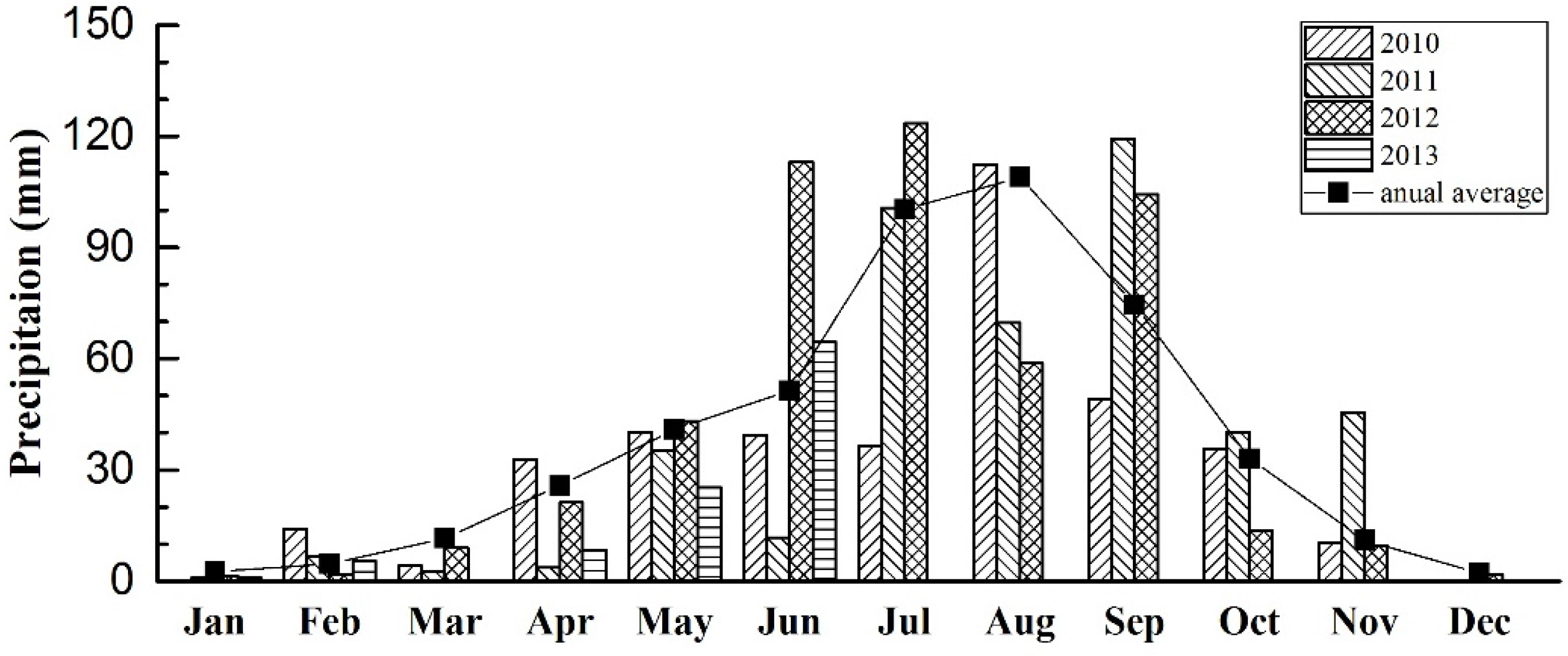

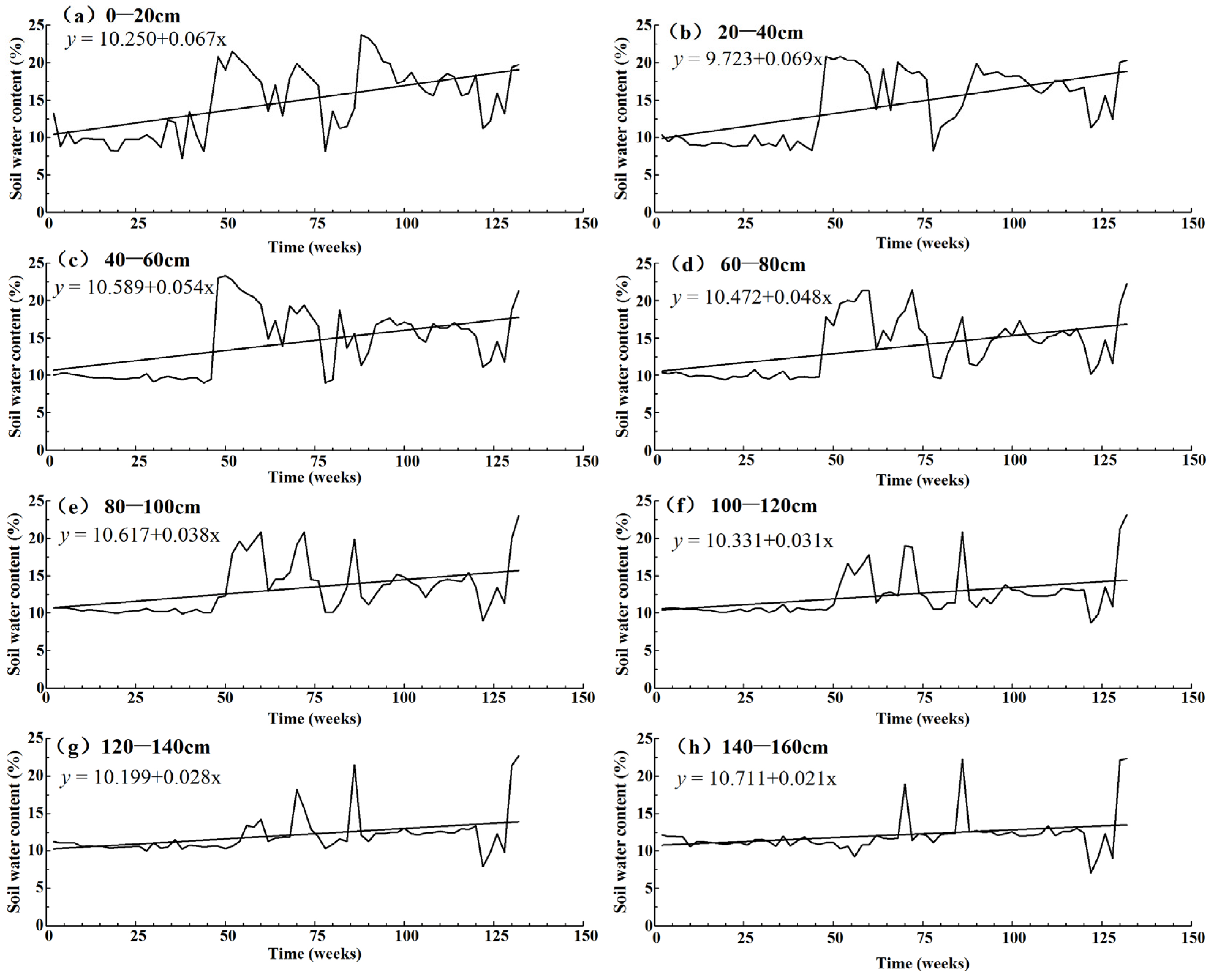
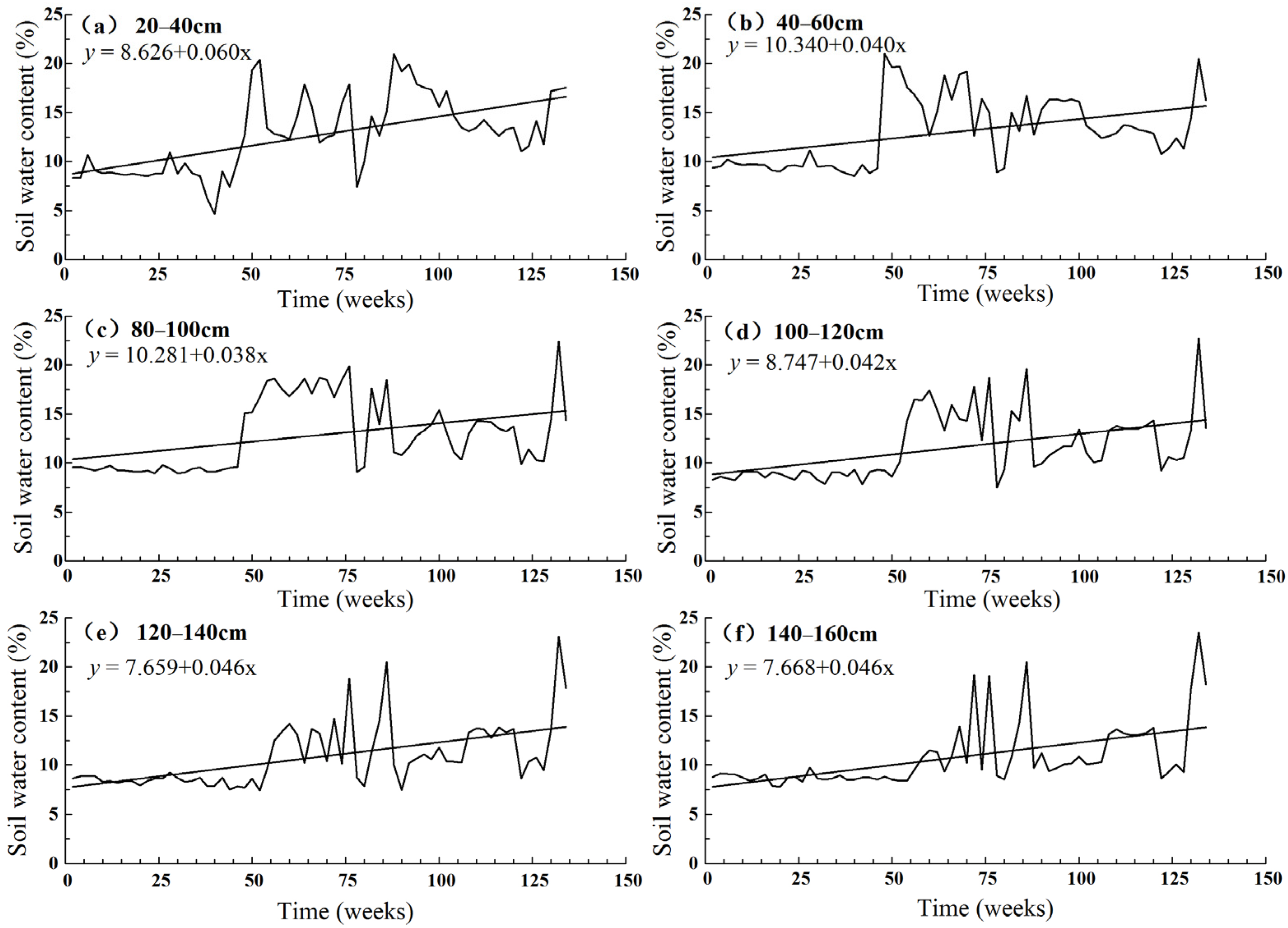
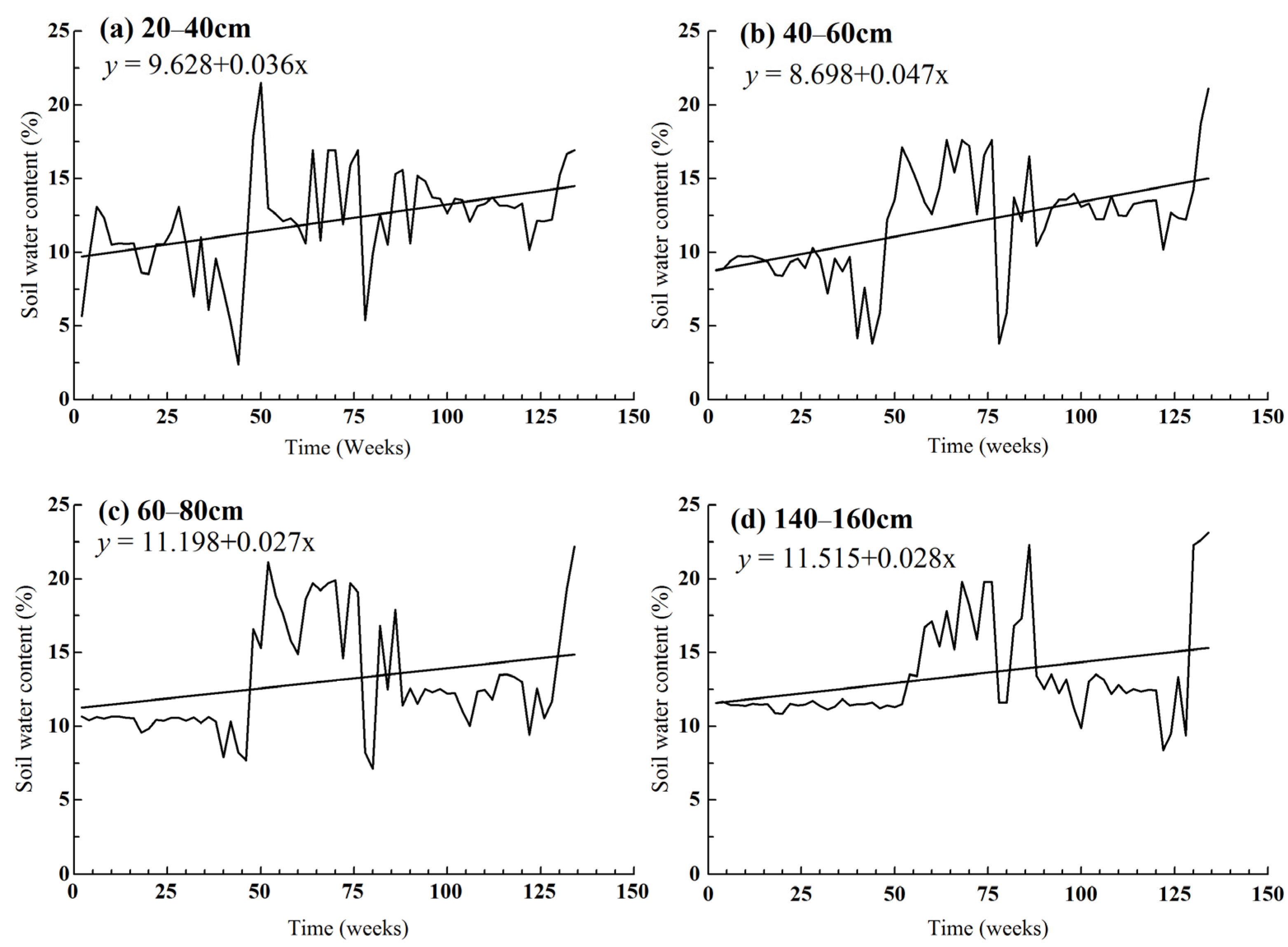
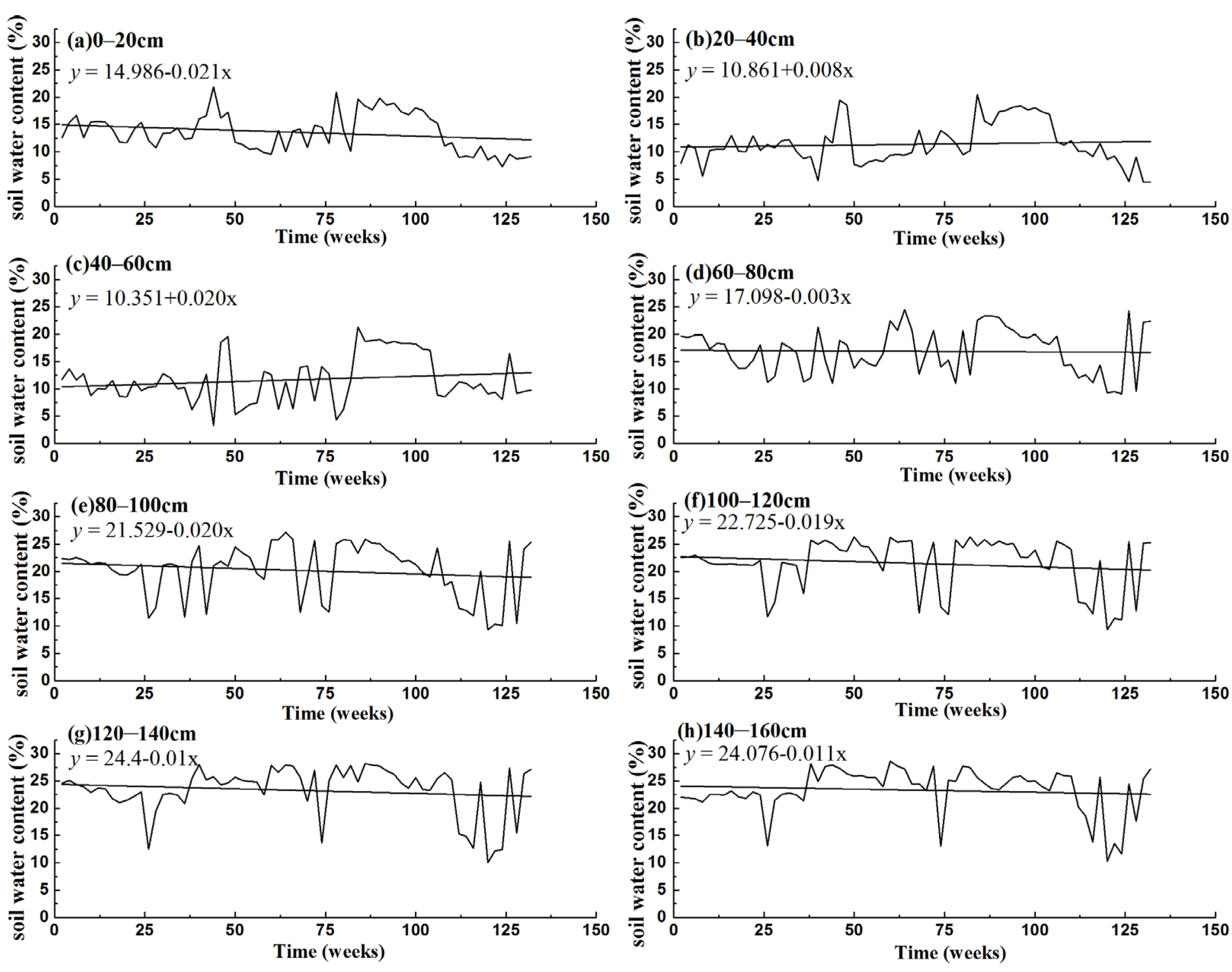
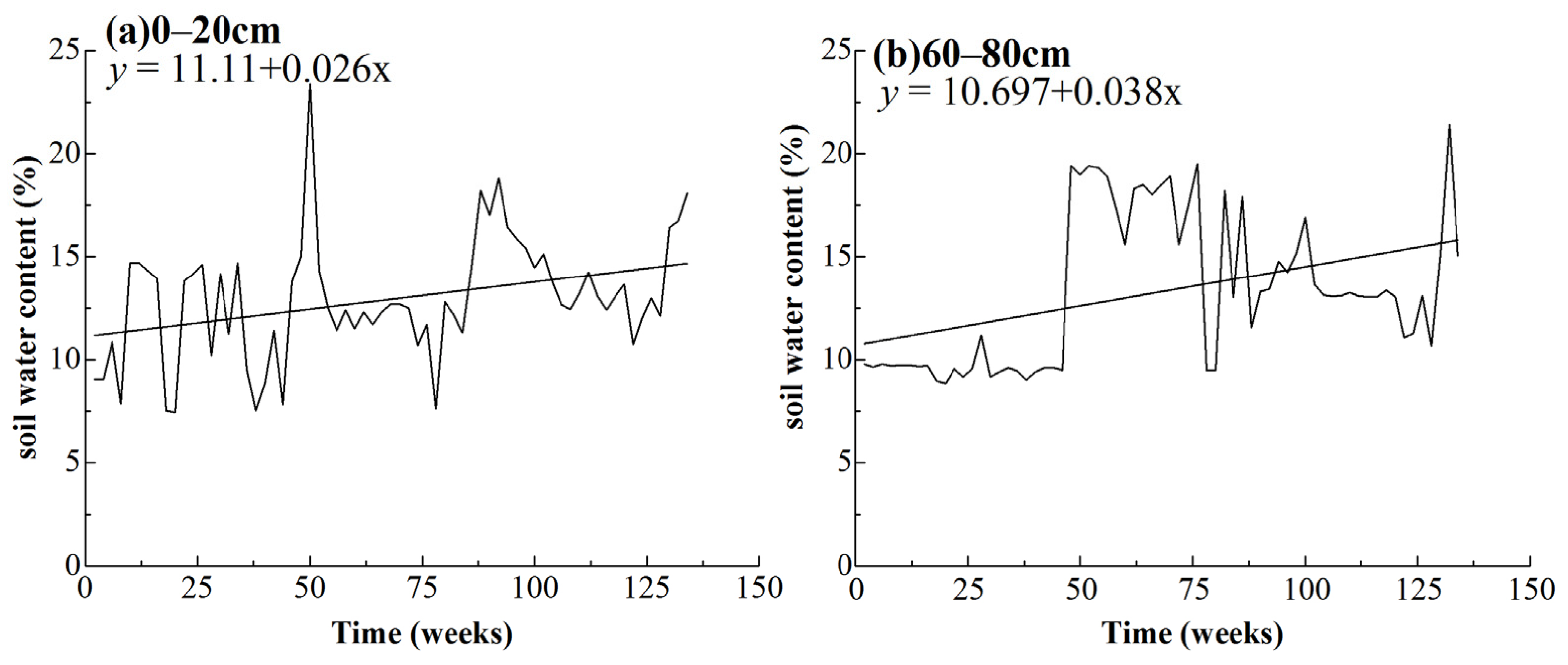
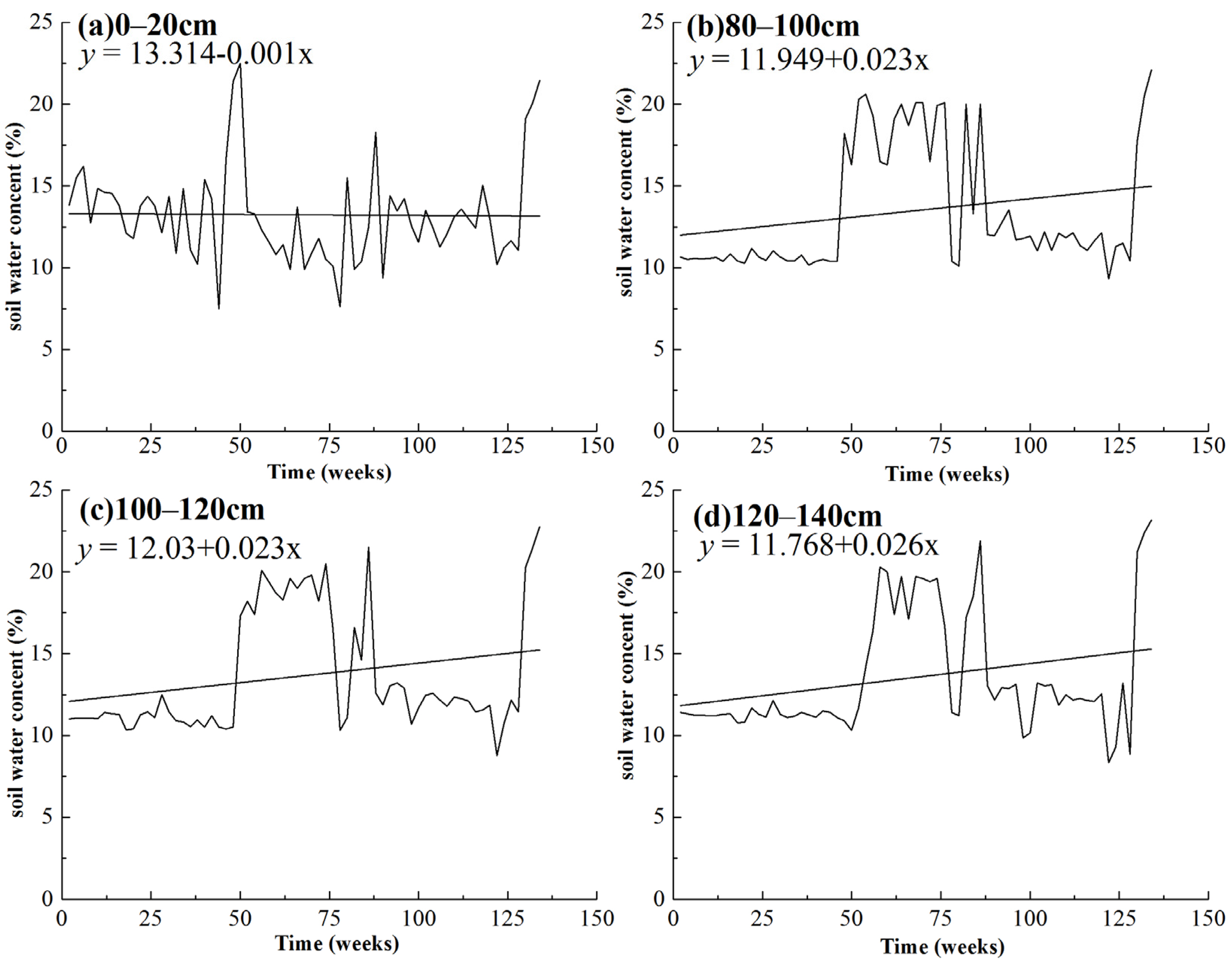
| Vegetation Type | Slope Aspect | Slope Position | Land Preparation Method | Bucket Height/m | Area/hm2 | Stand Age/Year | Stand Density/Plants·hm−2 | Mean Height/m | Mean Diameter/cm |
|---|---|---|---|---|---|---|---|---|---|
| Pinus tabulaeformis Carr. plantation | West slope | Middle | Level bench | 1.5 | 2 | 19/22 | 1600/1600 | 4.2/4.4 | 17.2/17.5 |
| Prunus sibirica L. plantation | West slope | Middle | Level bench | 1.5 | 2 | 19/22 | 1600/1600 | 3.6/3.7 | 12.5/12.5 |
| Hippophae rhamnoides Linn. shrub | West slope | Middle | Level bench | 1.0 | 5 | 12/15 | 3000/2800 | 1.7/1.9 | 4.2/4.3 |
| Natural grassland | West slope | Middle | No | – | – | – | – | – | – |
| Vegetation Types | Test | Soil Layer (cm) | |||||||||
|---|---|---|---|---|---|---|---|---|---|---|---|
| 0–20 | 20–40 | 40–60 | 60–80 | 80–100 | 100–120 | 120–140 | 140–160 | Min | Max | ||
| Pinus tabulaeformis Carr. plantation | r1 | 0.738 | 0.796 | 0.737 | 0.731 | 0.645 | 0.459 | 0.357 | 0.263 | −0.257 | 0.226 |
| r’1 | −0.084 | −0.118 | −0.011 | 0.047 | 0.134 | 0.112 | 0.110 | 0.063 | −0.259 | 0.228 | |
| Prunus sibirica L. plantation | r1 | 0.465 | 0.743 | 0.710 | 0.692 | 0.702 | 0.540 | 0.498 | 0.435 | −0.255 | 0.224 |
| r’1 | −0.026 | 0.017 | −0.051 | −0.143 | −0.084 | −0.120 | 0.012 | −0.104 | −0.257 | 0.226 | |
| Hippophae rhamnoides Linn. shrub | r1 | 0.335 | 0.438 | 0.608 | 0.628 | 0.675 | 0.735 | 0.699 | 0.600 | −0.255 | 0.224 |
| r’1 | 0.034 | 0.032 | 0.039 | −0.025 | −0.099 | 0.018 | 0.075 | 0.027 | −0.257 | 0.226 | |
| Natural grassland | r1 | 0.623 | 0.621 | 0.449 | 0.300 | 0.291 | 0.351 | 0.380 | 0.359 | −0.257 | 0.226 |
| r’1 | −0.142 | −0.038 | −0.020 | −0.062 | −0.022 | −0.040 | −0.109 | −0.126 | −0.259 | 0.228 | |
| Vegetation Types | Test | Soil Layer (cm) | |||||||
|---|---|---|---|---|---|---|---|---|---|
| 0–20 | 20–40 | 40–60 | 60–80 | 80–100 | 100–120 | 120–140 | 140–160 | ||
| Pinus tabulaeformis Carr. plantation | Zs | 2.50 * | 3.02 ** | 2.79 ** | 2.73 ** | 2.60 ** | 3.32 ** | 4.36 ** | 3.45 ** |
| b (%/weeks) | 0.067 | 0.069 | 0.054 | 0.048 | 0.038 | 0.031 | 0.028 | 0.021 | |
| Prunus sibirica L. plantation | Zs | 1.62 | 2.45 * | 2.01 * | 1.93 | 2.04 * | 3.27 ** | 3.05 ** | 3.65 ** |
| b (%/weeks) | 0.026 | 0.060 | 0.040 | 0.038 | 0.038 | 0.042 | 0.046 | 0.046 | |
| Hippophae rhamnoides Linn. shrub | Zs | −0.23 | 2.24 * | 3.46 ** | 2.07 * | 1.51 | 1.46 | 1.82 | 2.06 * |
| b (%/weeks) | −0.001 | 0.036 | 0.047 | 0.027 | 0.023 | 0.023 | 0.026 | 0.028 | |
| Natural grassland | Zs | −1.66 | −0.44 | 0.66 | −0.26 | −0.31 | −0.52 | −0.95 | −1.17 |
| b (%/weeks) | −0.021 | −0.008 | 0.020 | −0.003 | −0.002 | −0.019 | −0.01 | −0.011 | |
© 2016 by the authors; licensee MDPI, Basel, Switzerland. This article is an open access article distributed under the terms and conditions of the Creative Commons Attribution (CC-BY) license (http://creativecommons.org/licenses/by/4.0/).
Share and Cite
Wang, Y.; Zhu, Q.-K.; Zhao, W.-J.; Ma, H.; Wang, R.; Ai, N. The Dynamic Trend of Soil Water Content in Artificial Forests on the Loess Plateau, China. Forests 2016, 7, 236. https://doi.org/10.3390/f7100236
Wang Y, Zhu Q-K, Zhao W-J, Ma H, Wang R, Ai N. The Dynamic Trend of Soil Water Content in Artificial Forests on the Loess Plateau, China. Forests. 2016; 7(10):236. https://doi.org/10.3390/f7100236
Chicago/Turabian StyleWang, Yu, Qing-Ke Zhu, Wei-Jun Zhao, Huan Ma, Rui Wang, and Ning Ai. 2016. "The Dynamic Trend of Soil Water Content in Artificial Forests on the Loess Plateau, China" Forests 7, no. 10: 236. https://doi.org/10.3390/f7100236
APA StyleWang, Y., Zhu, Q.-K., Zhao, W.-J., Ma, H., Wang, R., & Ai, N. (2016). The Dynamic Trend of Soil Water Content in Artificial Forests on the Loess Plateau, China. Forests, 7(10), 236. https://doi.org/10.3390/f7100236






